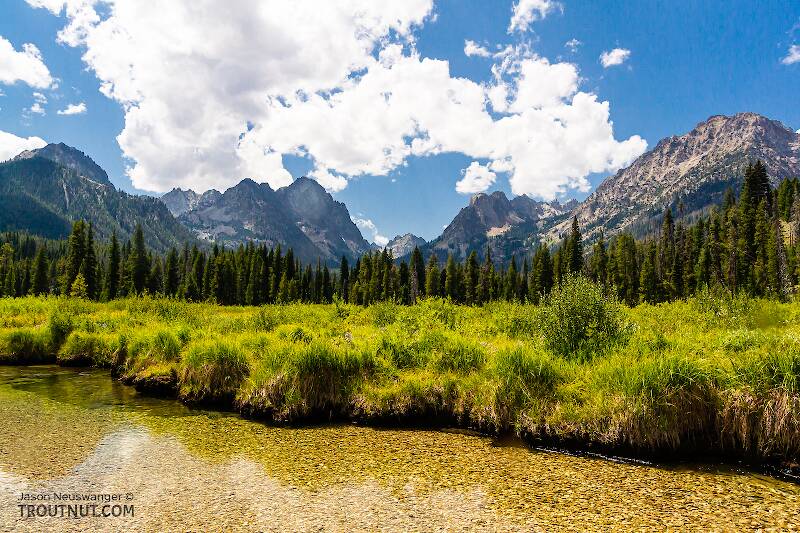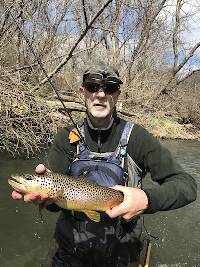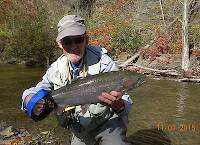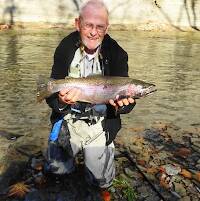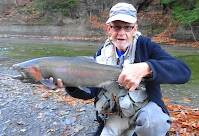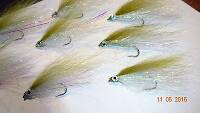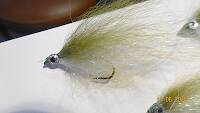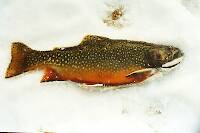
Blue-winged Olives
Baetis
Tiny Baetis mayflies are perhaps the most commonly encountered and imitated by anglers on all American trout streams due to their great abundance, widespread distribution, and trout-friendly emergence habits.
Featured on the forum

Troutnut is a project started in 2003 by salmonid ecologist Jason "Troutnut" Neuswanger to help anglers and
fly tyers unabashedly embrace the entomological side of the sport. Learn more about Troutnut or
support the project for an enhanced experience here.
This discussion is about the Little Juniata River.
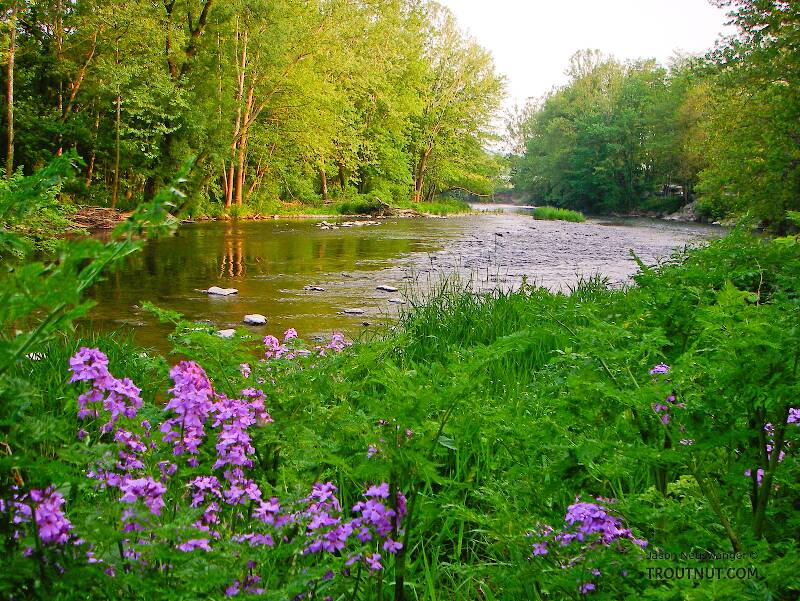
Troutboomer on Feb 7, 2010February 7th, 2010, 9:50 am EST
This is my first post here although I have looked at Troutnut pictures for several years and have refered many people to Jason's fine website. I know some of you from my Spruce creek Fly Co. days and as leader of the Little Juniata River Association. Casey, Louis Martin and others, who lurk here, have contributed to the LJRA forum in the past and I know they have interest in the "j" as a great trout fishery.
I thought, having read the thread from a couple of years ago and seen the Little "j" mentioned, I would bring the subject of wild fish versus domestic hatchery fish back up. After fishing the "j" for 30+ years and now being in the (unpaid) business of preserving and improving it, I am convinced (no solid evidence) that the fingerling browns we help stock each year, are little more than expensive food for our stream bred trout. This past season we, (LJRA and PAFBC) took two important steps. First, all 30,000 fingerlings stocked in May 2009 were permanently marked by clipping the adipose fin. This will be repeated in 2010 and 2011. The sites of the stockings will be electro surveyed each year and the survivability of hatchery trout will be thus estimated. Second, in November 2009 we helped to perform a redd count on 7 miles of river (details on the LJRA website). We counted over 300 redds, many with trout still on them actively engaged in spawning activity. So much for the "too cemented" argument. Every where we found suitable gravel, such as in tailouts and behind bridge abutments, we found redds. So, If any of you catch a trout in the "j" this year that is less than 10 inches long, without a clipped fin, know that it was born wild. (Louis won't have to spot speculate any longer). We are real interested in hearing your reports of clipped versus not clipped.
Bill Anderson
I thought, having read the thread from a couple of years ago and seen the Little "j" mentioned, I would bring the subject of wild fish versus domestic hatchery fish back up. After fishing the "j" for 30+ years and now being in the (unpaid) business of preserving and improving it, I am convinced (no solid evidence) that the fingerling browns we help stock each year, are little more than expensive food for our stream bred trout. This past season we, (LJRA and PAFBC) took two important steps. First, all 30,000 fingerlings stocked in May 2009 were permanently marked by clipping the adipose fin. This will be repeated in 2010 and 2011. The sites of the stockings will be electro surveyed each year and the survivability of hatchery trout will be thus estimated. Second, in November 2009 we helped to perform a redd count on 7 miles of river (details on the LJRA website). We counted over 300 redds, many with trout still on them actively engaged in spawning activity. So much for the "too cemented" argument. Every where we found suitable gravel, such as in tailouts and behind bridge abutments, we found redds. So, If any of you catch a trout in the "j" this year that is less than 10 inches long, without a clipped fin, know that it was born wild. (Louis won't have to spot speculate any longer). We are real interested in hearing your reports of clipped versus not clipped.
Bill Anderson
Shawnny3 on Feb 7, 2010February 7th, 2010, 2:11 pm EST
Very interesting information, Bill. I have not fished the Little J too much, but I do enjoy it from time to time. Thank you for your efforts to make it an even better fishery than it already is.
-Shawn
-Shawn
Jewelry-Quality Artistic Salmon Flies, by Shawn Davis
www.davisflydesigns.com
www.davisflydesigns.com
Troutnut on Feb 7, 2010February 7th, 2010, 6:44 pm EST
It's great that you guys are doing a study on the survivorship of those stockers! Too often people just blindly continue policies without checking to see if they're working.
Jason Neuswanger, Ph.D.
Troutnut and salmonid ecologist
Troutnut and salmonid ecologist
Troutnut on Feb 7, 2010February 7th, 2010, 6:44 pm EST
It's great that you guys are doing a study on the survivorship of those stockers! Too often people just blindly continue policies without checking to see if they're working.
Jason Neuswanger, Ph.D.
Troutnut and salmonid ecologist
Troutnut and salmonid ecologist
JAD on Feb 8, 2010February 8th, 2010, 4:38 am EST
Hi Bill
I'm glad you decided to post. Way back when, we used to post on your old board I meet Louis and Lloyd. Some of the members on the board have been talking about fishing the Little J together and sharing a dinner and a few beers at the Main st.Cafe.
Keep up the flght and as always the Best
Caddisman1
JAD
I'm glad you decided to post. Way back when, we used to post on your old board I meet Louis and Lloyd. Some of the members on the board have been talking about fishing the Little J together and sharing a dinner and a few beers at the Main st.Cafe.
Keep up the flght and as always the Best
Caddisman1
JAD
They fasten red (crimson red) wool around a hook, and fix onto the wool two feathers which grow under a cock’s wattles, and which in colour are like wax.
Radcliffe's Fishing from the Earliest Times,
RleeP on Feb 8, 2010February 8th, 2010, 8:25 am EST
This is is slightly off topic, but still something worth pondering, IMO..
I'd love to see PFBC (or one of the Co-ops with PFBC aid/sanction) try a wild brown trout fingerling pilot in one of PA's limestones where they seem to believe that some sort of stocking (whether fingerlings or catchables) remains required to bring fish density up to a level sufficient to support however it is they define a quality recreational fishery these days.
Wisconsin's fishery managers have had excellent success in establishing self-sustaining, pretty high density wild trout pops. in some of their Class II (often streams with good thermal and chemical profiles that lack spawning habitat) limestones in the SW portion of the state. They stopped stocking fingerlings from hatchery strains and started stocking wild fingerlings they got the eggs for from a couple streams that have too many fish. And in many cases, these plantings took off and formed the foundation for a fully self-sustaining population and now no fish at all are planted in these places. They don't need them. While a number of the streams that experienced these explosions in wild fish also had significant habitat work done on them, not all of them were worked on and the increase in fish numbers seems to be occurring in all areas of the streams, improved and not improved. There's something going on with these success stories that is about more than habitat improvement. I think there is something inherent in the wild fingerlings that works in a sort of "life finds a way" quote manner from Jurassic Park. they out-survive and out spawn the hatchery strain fingerlings many times over, evidently..
While the Little J is much larger than any of these WI streams, it has the forage base, water chemistry and thermal regimes that might really benefit from this sort of approach. I'd like to see them try it in PA and I think the Little J., despite its large size might be a good place to try it, or at least a modest pilot. They could get the spawners to do it with from any number of places; Spring Creek, the Logan Branch, Tea Creek (if it is back and fully recovered from the big kill a few years back) or even one of the Cumberland Valley Creeks, if current biomass is high enough. Or any or a dozen or more other small PA limestones that are at or even above carrying capacity at present.
In my view, this could be a much more effective way of maintaining a high density fishery than any regs could ever be. And if it were to work, it has the potential to solve the fingerling plant issue on the Little J once and for all in favor of a high-density all wild fishery.
Or I may be behind the times/news and the river could do well without the current fingerlings and relying solely upon whatever recruitment currently occurs. I have my doubts though. Still, its been a decade since I fished it regularly, so bear that in mind.
All in all, just a thought. I've been so impressed with the WI wild fingerling program that I'm really eager to see something similar tried back home in PA.
I'd love to see PFBC (or one of the Co-ops with PFBC aid/sanction) try a wild brown trout fingerling pilot in one of PA's limestones where they seem to believe that some sort of stocking (whether fingerlings or catchables) remains required to bring fish density up to a level sufficient to support however it is they define a quality recreational fishery these days.
Wisconsin's fishery managers have had excellent success in establishing self-sustaining, pretty high density wild trout pops. in some of their Class II (often streams with good thermal and chemical profiles that lack spawning habitat) limestones in the SW portion of the state. They stopped stocking fingerlings from hatchery strains and started stocking wild fingerlings they got the eggs for from a couple streams that have too many fish. And in many cases, these plantings took off and formed the foundation for a fully self-sustaining population and now no fish at all are planted in these places. They don't need them. While a number of the streams that experienced these explosions in wild fish also had significant habitat work done on them, not all of them were worked on and the increase in fish numbers seems to be occurring in all areas of the streams, improved and not improved. There's something going on with these success stories that is about more than habitat improvement. I think there is something inherent in the wild fingerlings that works in a sort of "life finds a way" quote manner from Jurassic Park. they out-survive and out spawn the hatchery strain fingerlings many times over, evidently..
While the Little J is much larger than any of these WI streams, it has the forage base, water chemistry and thermal regimes that might really benefit from this sort of approach. I'd like to see them try it in PA and I think the Little J., despite its large size might be a good place to try it, or at least a modest pilot. They could get the spawners to do it with from any number of places; Spring Creek, the Logan Branch, Tea Creek (if it is back and fully recovered from the big kill a few years back) or even one of the Cumberland Valley Creeks, if current biomass is high enough. Or any or a dozen or more other small PA limestones that are at or even above carrying capacity at present.
In my view, this could be a much more effective way of maintaining a high density fishery than any regs could ever be. And if it were to work, it has the potential to solve the fingerling plant issue on the Little J once and for all in favor of a high-density all wild fishery.
Or I may be behind the times/news and the river could do well without the current fingerlings and relying solely upon whatever recruitment currently occurs. I have my doubts though. Still, its been a decade since I fished it regularly, so bear that in mind.
All in all, just a thought. I've been so impressed with the WI wild fingerling program that I'm really eager to see something similar tried back home in PA.
Martinlf on Feb 9, 2010February 9th, 2010, 5:27 am EST
Bill, welcome to the forum. Hope to see you on here from time to time. I'll send along any information I can on clipped vs. not--if I can manage to catch a fish or two in the coming season.
"He spread them a yard and a half. 'And every one that got away is this big.'"
--Fred Chappell
--Fred Chappell
Shawnny3 on Feb 9, 2010February 9th, 2010, 1:18 pm EST
if I can manage to catch a fish or two in the coming season.
Nice one, Louis. If you don't catch a few fish this season, then the fishery is in a lot worse shape than anyone imagines.
-Shawn
Jewelry-Quality Artistic Salmon Flies, by Shawn Davis
www.davisflydesigns.com
www.davisflydesigns.com
JAD on Feb 10, 2010February 10th, 2010, 2:14 am EST
Shawn
Not to speak for Louis ------But, Louis has a hard time catching small fish. I think that's why he keeps me around but then again I'm a good net man.
JAD
Not to speak for Louis ------But, Louis has a hard time catching small fish. I think that's why he keeps me around but then again I'm a good net man.
JAD
They fasten red (crimson red) wool around a hook, and fix onto the wool two feathers which grow under a cock’s wattles, and which in colour are like wax.
Radcliffe's Fishing from the Earliest Times,
Troutboomer on Feb 24, 2010February 24th, 2010, 6:24 am EST
Caddisman,
Anytime you Luois and Loyd want to do that Mainstreat Cafe thing let me know. I'll be there.
RleeP,
We too have watched and learned from the Wisconsin experience. Our plan is to capture proven wild breeders from the "j", strip eggs and milt, then incubate them in "j" tributaries where conditions are prime. We may have a real opportunity to do this in a big way if we can get the Sandy Run spring into PFBC hands. Its going to be real interesting to see how many of the clipped hatchery fish turn up in the PFCB survey in May.
Bill Anderson
LJRA
President
Anytime you Luois and Loyd want to do that Mainstreat Cafe thing let me know. I'll be there.
RleeP,
We too have watched and learned from the Wisconsin experience. Our plan is to capture proven wild breeders from the "j", strip eggs and milt, then incubate them in "j" tributaries where conditions are prime. We may have a real opportunity to do this in a big way if we can get the Sandy Run spring into PFBC hands. Its going to be real interesting to see how many of the clipped hatchery fish turn up in the PFCB survey in May.
Bill Anderson
LJRA
President
CaseyP on Feb 24, 2010February 24th, 2010, 8:16 am EST
"You can observe a lot by watching." Yogi Berra
Quick Reply
Related Discussions
Topic
Replies
Last Reply
23
Aug 13, 2014
by Reelin_good
by Reelin_good
1
Sep 14, 2010
by SlateDrake9
by SlateDrake9
1
Mar 10, 2007
by Troutnut
by Troutnut

